From MicrotracReviewed by Emily MageeMar 31 2022
?This interview conducted with Dr. Daniel Hagmeyer, Product Specialist for Dynamic Light Scattering at Microtrac MRB Haan/Germany, discusses particle characterization, advantages of zeta potential analyzers, and the newly acquired Stabino Zeta Analyzer.
Could you describe what Zeta Potential Analysis is and what it is used for?
Zeta potential analysis is an indirect measurement of the surface charge of particles or droplets which are dispersed in a polar liquid. In this case, an electrical double layer is usually formed, consisting of ions in the liquid. If the particle moves in the liquid, or the particles remain stationary and the liquid moves, the electrical double layer moves with it, along the so-called slipping plane. The electric potential at this slipping plane is the zeta potential.
The zeta potential is a first indicatior for the stability of a dispersion or emulsion. More information about the stability can be obtained through fast titrations to determine, for example, the charge density of the dispersion.
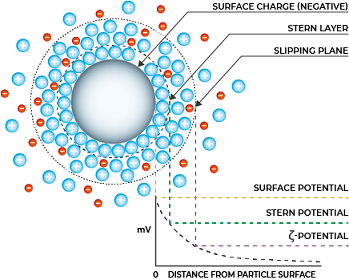
Image Credit: Microtrac
??????Can you explain why this field has grown and how the demand for Zeta Potential Analyzers has developed over the past few years?
Zeta potental measurement, and also particle size measurement, has increased as nanotechnology has gained traction in recent years in the field of dispersions and emulsions in a variety of applications such as inks, ceramics and beverages, to name only a few.
How has Microtrac stayed ahead of these changes?
Microtrac has longstanding experience in zeta potential measument since we launched the Zetatrac analyzer in 2008. The first DLS system was developed in 1991 which was the Nanotrac UPA. In 2012, we introduced the new NANOTRAC WAVE and NANOTRAC Flex series for size and zeta potential measurement. With the new STABINO ZETA, we now expand our portfolio for zeta potential to measuring the particle size range and also concentration. This technology also permits very fast and detailed titrations. One other point is that the STABINO ZETA can work together with the NANOTRAC Flex as one unit.
What makes the STABINO ZETA an ideal replacement for classical zeta potential measurement?
The STABINO ZETA has many advantages over classical zeta potential measurement. First, you can measure 5 parameters like zeta potential, streaming potential, concductivity, pH and temperature quickly and simultaneously. The second point is the easy-to-use "Mix and Measure" method of the STABINO ZETA which saves time by performing very fast titrations. These titrations can be done with an incorporated adjusted titration speed. The third advantage is the particle size range for zeta potential measument from 0.3 nm to 300 µm which is significantly higher than electrophoretic methods. Also, the sample concentration can be up to 40vol.%.
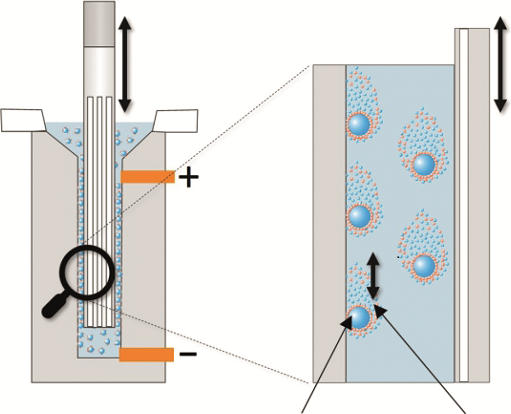
Measurement principle Zeta Streaming Potential.
Image Credit: Microtrac
How has STABINO ZETA’s measurement potential been optimized?
The STABINO ZETA has optimized the zeta potential measurement in that we do not need any sample parameters like optical parameters (refractive index and particle form), viscosity or dielectric constant. It is possible to measure samples without any prior knowledge. Also, the built-in titration unit provides real ongoing titrations in contrast to an external autotitrator which is used with electrophoresis units.
What parameters can STABINO ZETA measure?
The STABINO ZETA provides very fast, precise, and reproducible zeta potential measurements due to its high resolution and data point density. The analyzer can determine 5 parameters simultaneously within a few seconds: zeta potential, streaming potential, conductivity, pH value and temperature. When used in combination with Microtrac’s unique NANOTRAC FLEX, particle size can be measured simultaneously in the same sample.
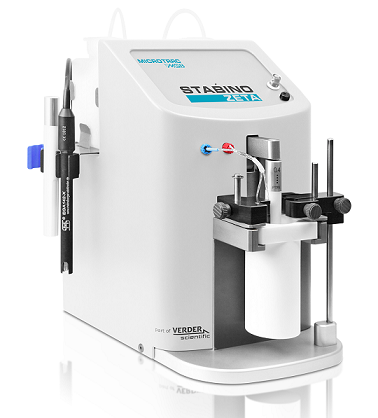
Image Credit: Microtrac
Could you name some of the benefits of the STABINO ZETA?
The STABINO ZETA has many benefits, not least, the capability to perform very fast titrations. The built-in titration function allows for simultaneous determination of all parameters at every titration dosage step. All titrations can be done within a few minutes.
Titration applications include pH titration to determine the isoelectric point or stable pH ranges of dispersions. The polyelectrolyte titration can be used for the determination of colloidal stability or / and the charge density which gives a much better understanding of the stability of the dispersion. Polyelecrolyte titrations also can be used for dispersant optimization or the optimization of product formulation. Last but not least also salt / conductivity titrations can be done to learn more about the zeta potential as a function of conductivity.
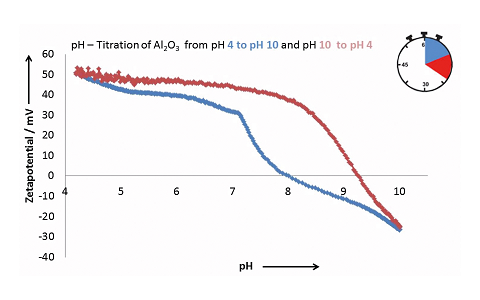
pH Titration.
Image Credit: Microtrac
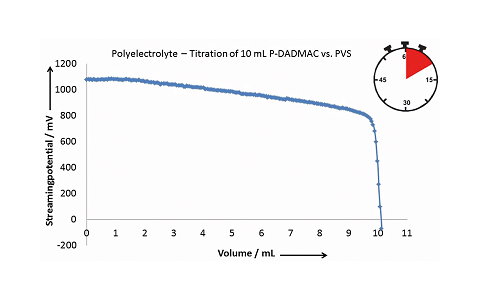
Polyelectrolyte Titration.
Image Credit: Microtrac
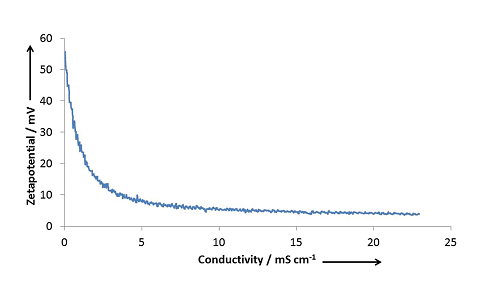
Salt Titration.
Image Credit: Microtrac
How will users feel these benefits?
The user will feel these benefits in the time savings for the actual measurement process and the easy handling of the system. Moreover, new information and improvements of the dispersion can be learned from the titration. In general, the user will gain much more information about his samples than before.
Why can the STABINO ZETA also be used for measuring particle size?
The STABINO ZETA itself cannot measure particle size, it is a zeta potential analyzer with a built-in titrator. To perform size measurements in a range from 0.3 nm up to 10 µm, the STABINO ZETA must be coupled to the NANOTRAC FLEX which is a Dynamic Lightscattering (DLS) Measurement System.
Thanks to the unique probe design of the NANOTRAC FLEX every vessel can be used as a measurement cell, so there is no need for cuvettes of any kind. This enables the use of the probe in combination with STABINO ZETA to monitor the particle size during a titration. During the titration, the NANOTRAC FLEX will be remotely controlled from the STABINO ZETA software, so the two operate as one unit. Of course, both units can be run as stand-alone systems which gives the user high flexibility for their measurements.
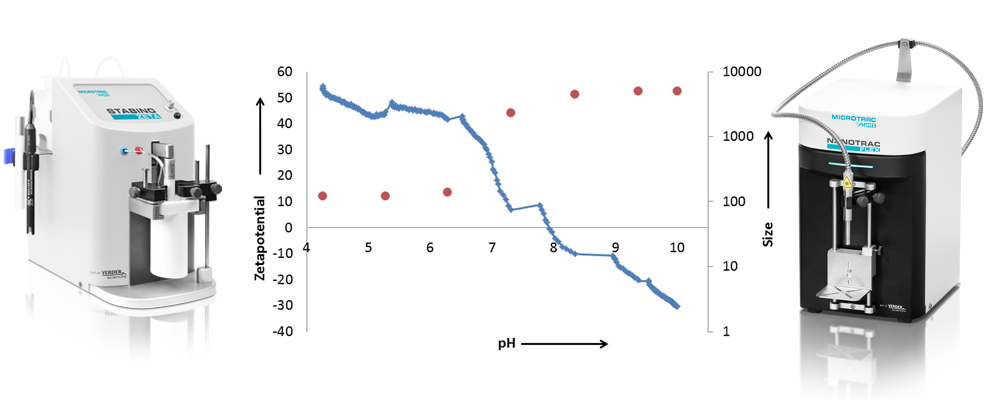
Image Credit: Microtrac
What’s next for Microtrac MRB?
Our aim is to provide solutions which improve the work of our customers. Our efforts do not end after purchase or installation. We also offer after-sales service and support as well as knowledge transfer through webinars. It is very important for us is to know the needs of our customers, so that we can react to those needs. Therefore, our team is constantly improving our instruments and developing both hardware and software to explore new fields of applications.
Finally, new product releases and updates are scheduled for 2022, like the new NANOTRAC FLEX which we released in March 2022, so I recommend signing up to our customer newsletter to stay tuned and informed about our latest news.
About Dr. Daniel Hagmeyer 
Daniel Hagmeyer completed his PhD in inorganic chemistry in May 2011 in the research group of Prof. Dr. Epple. After the PhD, he worked at Particle Metrix as a product manager for colloidal measurement systems where he was responsible for the development of the Stabino Zeta. He then joined Microtrac BEL where he was responsible for service and application of porosity and pore size analyzers.
Since 2021 he is responsible for the international product management and applications in the field of laser diffraction and dynamic light scattering at Microtrac MRB, Germany.

This information has been sourced, reviewed and adapted from materials provided by Microtrac.
For more information on this source, please visit Microtrac.
Disclaimer: The views expressed here are those of the interviewee and do not necessarily represent the views of AZoM.com Limited (T/A) AZoNetwork, the owner and operator of this website. This disclaimer forms part of the Terms and Conditions of use of this website.